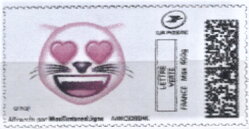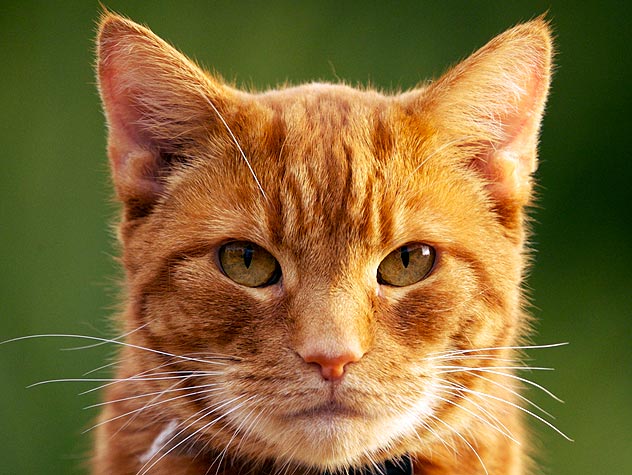Stamp: Loving Cat Emoji wih heart eyes (France 2019)
Loving Cat Emoji wih heart eyes (France 2019)
01 January (France ) within release MonTimbrEnLigne. Emojis goes into circulation Stamp Loving Cat Emoji wih heart eyes face value Lettre No Face Value
| Stamp Loving Cat Emoji wih heart eyes in catalogues | |
|---|---|
| Colnect codes: | Col: FR-TIM 2019-54a |
Stamp is square format.
Also in the issue MonTimbrEnLigne. Emojis:
- Stamp - Happy Emoji face value Prioritaire;
- Stamp - I have fallen in love with you. J'en pince pour toi face value Lettre;
- Stamp - I like it when you smile. J'aime quand tu souris face value Lettre;
- Stamp - Wedding Emojis x3 Bride Boquet Ring face value Lettre;
- Stamp - Wedding Emojis x3 Bride Ring Groom face value Lettre;
- Stamp - Wedding Emojis x3 Cake Spoon Cake face value Lettre;
- Stamp - Wedding Emojis x3 Church Bride Groom face value Lettre;
- Stamp - Wedding Emojis x3 Envelop sealed with a heart, List, Cake face value Lettre;
- Stamp - Wedding Emojis x5 Bride Bouquet Bridesmaids face value Lettre;
- Stamp - You make me see life in pink. Tu me fais voir la vie en rose face value Lettre;
- Stamp - Loving Cat Emoji wih heart eyes face value Lettre;
- Stamp - Smiling face with heart shaped eyes emoji face value Lettre;
- Stamp - Happy Emoji in Black, shaded face face value Lettre;
- Stamp - Hear no evil, see no evil, speak no evil Cat Emojis. black face value Lettre;
- Stamp - Cool Summer Emoji in black face value Lettre;
- Stamp - Four Bear Emojis in black face value Lettre;
- Stamp - Zipper Mouth Face Emoji. To keep a secret face value Lettre;
- Stamp - France Football Emoji in black face value Prioritaire;
|
Data entry completed
46%
|
|
|---|---|
| Stamp Loving Cat Emoji wih heart eyes in digits | |
| Country: | France |
| Date: | 2019-01-01 |
| Emission: | Personalized - Official |
| Format: | Stamp |
| Face Value: | Lettre No Face Value |
Stamp Loving Cat Emoji wih heart eyes it reflects the thematic directions:
A cartoon is a type of visual art that is typically drawn, frequently animated, in an unrealistic or semi-realistic style. The specific meaning has evolved, but the modern usage usually refers to either: an image or series of images intended for satire, caricature, or humor; or a motion picture that relies on a sequence of illustrations for its animation. Someone who creates cartoons in the first sense is called a cartoonist, and in the second sense they are usually called an animator.
The concept originated in the Middle Ages, and first described a preparatory drawing for a piece of art, such as a painting, fresco, tapestry, or stained glass window. In the 19th century, beginning in Punch magazine in 1843, cartoon came to refer – ironically at first – to humorous artworks in magazines and newspapers. Then it also was used for political cartoons and comic strips. When the medium developed, in the early 20th century, it began to refer to animated films that resembled print cartoons.
The domestic cat (Latin: Felis catus) is a small, typically furry, carnivorous mammal. They are often called house cats when kept as indoor pets or simply cats when there is no need to distinguish them from other felids and felines. Cats are often valued by humans for companionship and for their ability to hunt vermin. There are more than 70 cat breeds, though different associations proclaim different numbers according to their standards.
Cats are similar in anatomy to the other felids, with a strong flexible body, quick reflexes, sharp retractable claws, and teeth adapted to killing small prey. Cat senses fit a crepuscular and predatory ecological niche. Cats can hear sounds too faint or too high in frequency for human ears, such as those made by mice and other small animals. They can see in near darkness. Like most other mammals, cats have poorer color vision and a better sense of smell than humans. Cats, despite being solitary hunters, are a social species and cat communication includes the use of a variety of vocalizations (mewing, purring, trilling, hissing, growling, and grunting), as well as cat pheromones and types of cat-specific body language.
The heart is a muscular organ found in most animals. This organ pumps blood through the blood vessels of the circulatory system.The pumped blood carries oxygen and nutrients to the body, while carrying metabolic waste such as carbon dioxide to the lungs.In humans, the heart is approximately the size of a closed fist and is located between the lungs, in the middle compartment of the chest, called the mediastinum.
Love encompasses a range of strong and positive emotional and mental states, from the most sublime virtue or good habit, the deepest interpersonal affection, to the simplest pleasure. An example of this range of meanings is that the love of a mother differs from the love of a spouse, which differs from the love of food. Most commonly, love refers to a feeling of strong attraction and emotional attachment





